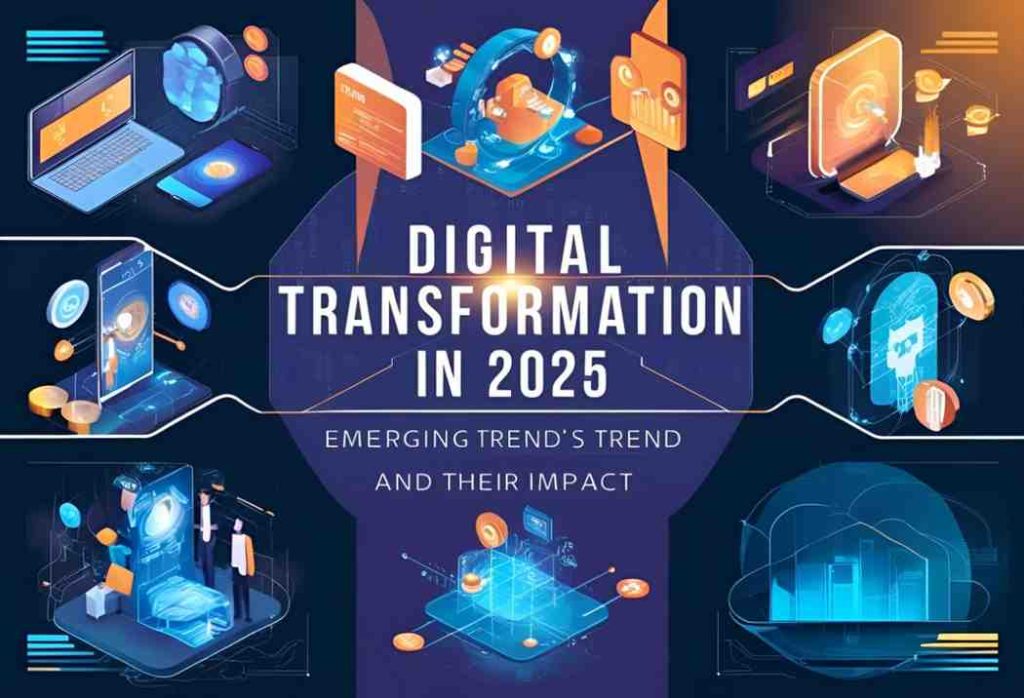Digital Transformation in 2025: Emerging Trends and Their Impact

As we navigate through 2025, digital transformation continues to reshape industries at an unprecedented pace. The convergence of advanced technologies is creating new opportunities while challenging traditional business models. This blog post explores the current state of digital transformation, examining the key trends driving change and their potential impact across sectors. From generative AI to spatial computing, we’ll delve into the technologies that are defining the digital landscape this year and provide insights on implementing successful transformation strategies.
Understanding Digital Transformation
Digital transformation is far more than simply purchasing new technology solutions. It represents a fundamental integration of digital technologies throughout an organization’s operations, requiring strategic alignment with business objectives and cultural change. As defined by experts, digital transformation occurs when “a company integrates digital technologies into its business operations, adopting them as part of a cohesive strategy and culture”[1]. This process fundamentally changes how businesses operate, engage employees, interact with suppliers, and deliver value to customers and other stakeholders.
The importance of digital transformation has accelerated significantly since the COVID-19 pandemic, with technology adoption rates increasing dramatically across sectors. Despite its importance, research indicates that only about 30% of companies successfully navigate their digital transformation journeys[1]. This highlights the complexity involved and the need for well-planned approaches.
Digital transformation encompasses several key components and technologies. These typically include analytics tools, mobile applications, platforms supporting shareable capabilities, and social media integration[1]. Additional technologies driving transformation include cloud computing, artificial intelligence, automation systems, and immersive technologies like augmented and virtual reality.
Key Components of Effective Digital Transformation
For transformation efforts to succeed, organizations must consider multiple dimensions beyond just technology implementation. The process requires alignment of people, processes, and technology with broader strategic goals. Digital transformation initiatives should focus on creating organizations that are more efficient, adaptive, and responsive to change rather than merely digitizing existing processes[1].
Successful digital transformation also requires clear vision and leadership. Organizations must be able to articulate what they hope to achieve and envision their desired end state. As noted by ICT experts, when embarking on digital transformation projects, it is advisable to “work with the end in mind, and be able to answer the questions: ‘What do we hope to achieve?’ and ‘At the end of the process, what would we like to see or experience?'”[2]. This clarity of purpose helps guide implementation efforts and maintain focus on strategic objectives.
Top Technology Trends Driving Digital Transformation in 2025
The digital landscape in 2025 is characterized by several emerging technologies that are fundamentally changing how organizations operate and deliver value. These technologies are not developing in isolation but rather intersect and complement each other, creating powerful new capabilities.
Generative AI and Agentic AI
Artificial Intelligence continues to be a driving force in 2025’s digital transformation landscape. Generative AI has evolved beyond basic content creation to become a sophisticated tool that helps businesses enhance user experiences, optimize workflows, and explore new opportunities in design, content creation, and interactive applications[3]. This technology enables organizations to automate creative processes while maintaining quality and consistency.
Simultaneously, Agentic AI—autonomous AI systems capable of independent decision-making—is seeing significant growth this year. These intelligent systems allow businesses to automate increasingly complex tasks, improve operational efficiency, and adapt quickly to market changes[3]. According to industry reports, approximately 25% of enterprises are expected to adopt AI agents by the end of 2025, indicating the growing importance of this technology in business operations[3].
The answer lies in using technology to drive greater efficiency.
Spatial computing is redefining how we interact with digital systems in 2025 by merging the physical and digital worlds. Advancements in Virtual Reality (VR) and Augmented Reality (AR) have enabled spatial computing to deliver truly immersive experiences across multiple sectors including gaming, professional training, retail, and education[3].
The hardware supporting these experiences has also evolved significantly, with lighter VR headsets, more capable AR glasses, and seamless integration of digital features into real-world environments becoming standard[3]. These developments are transforming industries by revolutionizing how people collaborate and interact in digital spaces, creating new opportunities for customer engagement and operational efficiency.
Advanced Connectivity
By 2025, 5G and its evolution to 5G-Advanced have become more widely implemented across various industries, including healthcare, manufacturing, transportation, and smart cities[4]. This advanced connectivity supports ultra-low latency applications such as autonomous vehicles and telemedicine that were previously constrained by bandwidth limitations.
Industry leaders have positioned 2025 as a milestone year for 5G-Advanced deployment globally. This next generation of mobile connectivity promises enhanced capacity, improved mobility, and tailored connectivity options, creating the foundation needed for new market opportunities on a greater scale[4]. The interplay between advanced connectivity and other emerging technologies is particularly significant, as high-speed, reliable networks enable the deployment of data-intensive applications like immersive experiences and real-time AI systems.
Cloud Computing Innovations
Cloud computing remains a cornerstone of digital transformation in 2025, continuing to revolutionize how organizations manage their IT resources. The technology has evolved to offer more sophisticated models including hybrid cloud, multi-cloud, serverless computing, and edge computing configurations that provide unprecedented flexibility and scalability[5].
Organizations are increasingly leveraging cloud technologies to achieve various benefits, including cost efficiency, operational flexibility, and enhanced reliability[5]. The ability to rapidly deploy and scale applications without significant capital investment has made cloud computing particularly valuable for organizations undergoing digital transformation, allowing them to experiment with new capabilities and adjust their technology footprint as needs evolve.
Implementation Strategies for Successful Digital Transformation
While the technologies driving digital transformation are powerful, their impact depends on effective implementation strategies. Organizations need structured approaches that address both technical and organizational aspects of transformation.
Reference
Digital transformation is not a one-size-fits-all exercise, but certain considerations can significantly increase the chances of success. First, organizations must clearly define their end vision before embarking on transformation initiatives[2]. This vision should articulate specific goals and outcomes rather than focusing on technology implementation.
Another critical factor is understanding that digital transformation affects all parts and levels of an organization. There should be “no sacred cows” in the process, as comprehensive transformation often requires rethinking fundamental business processes[2]. Organizations should avoid the common pitfall of simply introducing technology into existing processes without addressing underlying inefficiencies.
Successful digital transformation also requires integration of technology within the context of the whole business strategy. It’s not merely about buying new technology but integrating it in ways that consider broader organizational objectives and enhance operational capabilities[1]. This strategic alignment ensures that technology investments support real business needs rather than creating isolated digital capabilities.
Addressing Common Challenges
Organizations undertaking digital transformation frequently encounter challenges that can derail their efforts. Common obstacles include resistance to change, lack of necessary skills, insufficient leadership commitment, and unclear objectives. Addressing these challenges requires proactive planning and stakeholder engagement.
Change management becomes particularly important in transformation initiatives, as employees may be reluctant to adopt new ways of working. Organizations should invest in communication, training, and support systems that help staff understand the benefits of transformation and develop the skills needed to thrive in the new digital environment.
Data management represents another significant challenge, as digital transformation typically generates vast amounts of information that must be effectively organized and analyzed. Organizations need robust data governance frameworks and analytics capabilities to derive value from this data and support informed decision-making[4].
Impact of Digital Transformation Across Sectors
The effects of digital transformation extend across virtually all sectors of the economy, though the specific applications and impacts vary considerably.
Business and Industry
For established businesses, digital transformation offers opportunities to enhance operational efficiency, improve customer experiences, and develop new revenue streams. Technologies like AI and automation allow organizations to streamline processes and reduce costs, while data analytics provides insights that inform strategic decision-making.
Digital transformation also enables businesses to respond more effectively to market changes and customer demands. The ability to rapidly deploy new capabilities through cloud platforms and adjust operations based on real-time data represents a significant competitive advantage in dynamic market environments.
Startups and Innovation Ecosystems
Information and Communication Technology has played a transformative role in driving startup growth and innovation, particularly in developing economies like Nigeria[6]. The ICT revolution has facilitated the establishment of numerous startups by lowering barriers to entry and providing tools that support rapid scaling.
Startups are characterized by their pursuit of developing and marketing new products, services, or technologies that disrupt traditional industries or address unmet needs[6]. Digital transformation provides these enterprises with capabilities previously available only to large organizations, enabling them to compete effectively despite limited resources and operating history.
The startup ecosystem benefits from several characteristics of modern digital technologies, including reduced capital requirements, access to global markets, and the ability to leverage advanced capabilities through cloud services. These factors contribute to an environment where innovative ideas can be quickly tested and scaled if successful.
Public Sector and Governance
Digital transformation in the public sector focuses on improving service delivery, enhancing citizen engagement, and increasing operational efficiency. Governments worldwide are implementing digital strategies that enable online access to services, streamline administrative processes, and promote transparency.
The World Bank Group, as the largest international donor in ICT for development, has evolved its approach from helping developing countries build basic ICT infrastructure to supporting the implementation of sophisticated applications that deliver public and business services[7]. This shift reflects the maturing of digital technologies and their increasing role in addressing social and economic challenges.
Conclusion
As technologies continue to evolve, organizations must maintain adaptive approaches to digital transformation, continuously reassessing their strategies and capabilities. By embracing emerging technologies while focusing on delivering tangible business value, organizations can navigate the complex digital landscape and position themselves for long-term success in an increasingly digital world.
Successful digital transformation requires more than technology implementation; it demands strategic alignment, cultural change, and clear vision. Organizations that approach transformation holistically, considering people, processes, and technology in relation to their strategic objectives, are best positioned to realize the benefits of digital innovation.
As technologies continue to evolve, organizations must maintain adaptive approaches to digital transformation, continuously reassessing their strategies and capabilities. By embracing emerging technologies while focusing on delivering tangible business value, organizations can navigate the complex digital landscape and position themselves for long-term success in an increasingly digital world.
Reference
- https://www.imd.org/blog/digital-transformation/what-is-digital-transformation/
- https://ict-pulse.com/2022/02/6-essential-digital-transformation-tips-for-success/https://impactitsolutions.com/insights/top-5-technology-trends-of-2025/
- https://www.telecomreview.com/articles/reports-and-coverage/8735-ict-innovations-set-to-dominate-in-2025
- https://content-whale.com/blog/it-blog-topic-ideas/https://www.hostafrica.ng/blog/technology/impact-of-ict-on-startup-innovation/
- https://blogs.worldbank.org/en/digital-development/welcome-to-the-ict-blog



